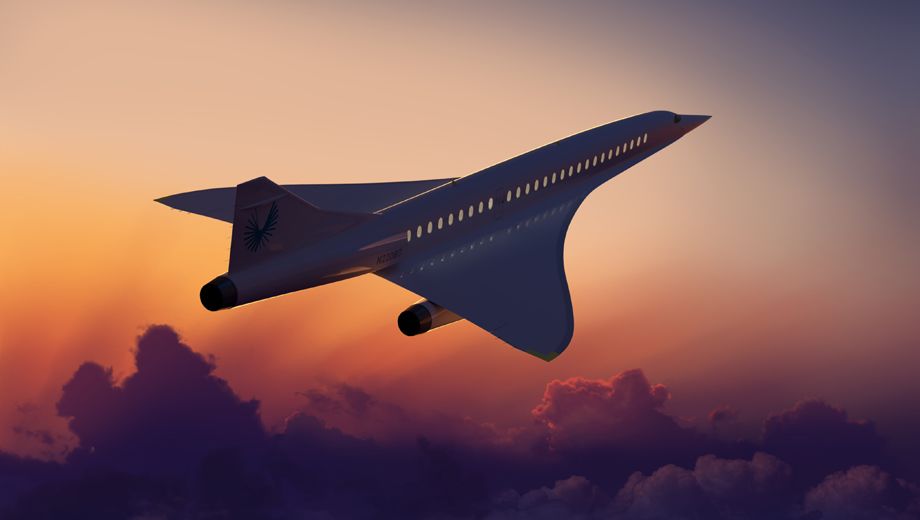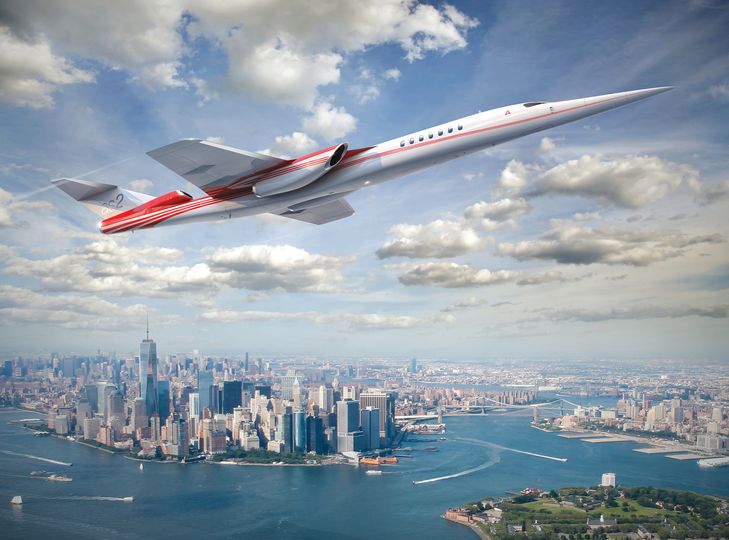Many business travellers are eagerly awaiting a supersonic renaissance, but delays to the new wave of faster-than-Corncorde jets – led by Boom's swept-wing Overture – might see the second era of supersonic travel end before it even begins.
The dream of flying passengers faster than the speed of sound gave birth to Concorde in the 1970s, only for the nightmare of making a profit to snuff it out less than three decades later.
Companies competing to build a successor to the iconic jet may find that the biggest hurdle isn’t technology or economics, but the hefty carbon footprint that’s the result of such eye-watering speeds – especially with mainstream plane and engine makers saying electric airliners may soon be within reach.
Driven by mounting public and political concerns about aviation emissions, the new-found environmental zeal of manufacturers such as Airbus threatens to make startups intent on breaking the sound barrier look like relics from a greedier age that spared little thought for the the environment.
That’s despite advances in aerodynamic design, materials and propulsion that have brought a second supersonic era tantalizingly close.
Can Boom's Overture become Concorde 2.0?
Carbon footprint aside, Boom Technology's vision of a supersonic future is certainly seductive.
Its 75-seat, Mach 2.2 jetliner, christened Overture, would dart between New York and London in 3.5 hours compared to the current seven-hour trek, with Hong Kong to Tokyo reduced to a two-hour dash.
There’d be no lie-flat seats because you’d never need to sleep aboard.
Boom says its aircraft would have operating costs 75% lower than those of Concorde, making more than 500 routes across the planet viable from the onset, rather than just London to New York in the case of the Anglo-French jet retired from service in 2003.
Yet the timeline mapped out by Scholl suggests that Boom – which boasts alumni of Airbus, Boeing, Lockheed Martin and NASA among its 150 staff – could fly straight into the biggest revolution in aviation since the dawn of the jet age in the 1950s.
Rollout of the one-third scale XB-1 is due in December, with its first flight in 2020. But a fully fledged airliner won’t take to the air for several more years, and service entry might not come until 2027.
The threat of the electric jet
By that point the first generation of hybrid-electric narrow-body jets will be well into development, with commercial operations targeted for 2035, according to Airbus projections.
Airbus Chief Technology Officer Grazia Vittadini said the company is now “very close” to beginning the shift away from its reliance on jet fuel.
“It’s a societal lead and a business imperative, not just a technology challenge,” she said. “We really need to strive for zero-emission aviation. This is the ultimate ambition.”
Those concerns were on display at last week’s Paris Air Show, where Boom founder and CEO Blake Scholl went out of his way to assert the plane’s green credentials.
Scholl revealed that an engine-testing program had tried out a high-concentration biofuel blend that proved to be 3% more efficient than traditional kerosene, then announced that Boom will partner with Prometheus Fuels, whose carbon-capture technology scrubs CO2 from the air and transforms it into liquid propellant.
Boom’s XB-1 demonstrator plane will “have history’s first zero net carbon footprint on a supersonic flight,” Scholl told an audience primed for news of dizzying speeds and thrust rather than a pitch on pollution.
“It’s important to do supersonic flight in a way that’s environmentally sustainable,” Scholl said. “It’s not good enough just to match the fuel efficiency and emission profile of current business class. We have to find a way to prove we are taking great care of the planet.”
Softening the supersonic boom
But noise issues remain, and Boom estimates of 1,000 to 2,000 orders (versus 14 Concordes), assume the plane won’t initially be able to operate over land.
Scholl said in an interview he takes the issue of changing public perceptions seriously, but that carriers are still clamoring to include a supersonic jet in their fleets.
“There isn’t an airline in the world that isn’t interested,” he said. “What they really want to know is whether we can we deliver.”
Two would-be customers have gone public with outline orders. Virgin Atlantic, which once tried to buy grounded Concordes for £1 million apiece to return them to service, wants 10 planes, while Japan Airlines has joined Boom as a strategic partner, invested US$10 million, and aims to buy 20.
Building the aircraft remains a huge challenge. With the July 2000 Concorde crash that killed 113 people seared into the collective memory, Scholl emphasized in Paris that safety is “job no. 1” and that the XB-1’s first flight had been pushed back from this year to add a “stability augmentation system” that will improve handling at high speeds and during takeoff and landing.
While Boom was strutting its stuff in Paris, Lockheed Martin used a conference in Dallas to unveil designs for a low-noise plane that would carry 40 passengers at Mach 1.8.
Though no more than a concept right now, the Quiet Supersonic Technology Airliner would make use of low-boom technology under development with NASA, opening up the possibility of overland flights.
The supersonic business jet
Boom’s biggest rival in the race to revive supersonic flight is Aerion, backed by Texas billionaire Robert Bass, which is following a different strategy with its planned AS2 model.
The Mach 1.4 aircraft would carry 12 people, putting it firmly in the business jet category and reflecting a view that Concorde failed partly because it was too big for its natural market.
Aerion, which has 20 outline orders from fractional ownership specialist Flexjet, made a splash earlier this year when it announced that Boeing would replace Lockheed Martin as an anchor investor.
Steve Nordlund, who heads Boeing’s NeXt future-technologies arm, said in Paris that while the AS2 provides a shortcut to competing in the supersonic market, Aerion’s awareness of the challenges that face very-high-fuel-consumption aircraft was also a major plus.
“They have a great mindset,” Nordlund said in an interview at the expo. “They had an approach around sustainability and the environmental effects of supersonic and that’s really, really important to us.”
That includes an understanding that new technologies need to comply with existing rules rather than requiring regulators to adapt, he said, adding that the notion of green supersonic travel shouldn’t be regarded as an oxymoron.
“You have to think about how materials are changing and getting lighter, think about the different fuels that could be used, how noise abatement could be done,” he said. “Engineers love to solve a problem.”





Virgin Australia - Velocity Rewards
13 Dec 2015
Total posts 30
Seems like a nobrainer for pacific aviation. The biggest barrier is to entry is government sponsorship. I can see a hub country looking for an edge soon, especially as smaller, direct, long-range flights put them under real pressure.
Qantas - Qantas Frequent Flyer
14 Sep 2012
Total posts 382
06 Jun 2018
Total posts 2
Biofuels will easily solve the Carbon Footprint issue of these supersonic airliners - liquid hydrocarbon is way more energy dense than even the best batteries so is going to have to be an option for a long time. Is Kerosene jet fuel really that different to Canola oil? Not as far as an industrial chemist is concerned.
Qantas - Qantas Frequent Flyer
10 Aug 2016
Total posts 64
I can't wait to go supersonic again. It's been too long (13 Aug 2002). Bring on Hydrogen as the fuel.
Qantas - Qantas Frequent Flyer
13 Nov 2018
Total posts 107
I’m extremely disappointed by the severe lack of knowledge by this writer (businessweek).
- After BA restructured their fares and made seats much more expensive, they made a profit up to the last service.
- The reason BA retired the Concorde was because after AirFrance pulled out, Airbus would not supply spare parts (or wouldn’t supply spares for a reasonable price) to BA
- The supersonic boom really wasn’t that bad; the media and the envious exaggerated the noise and its affect on people and animals (I acknowledge that landing and take off was very noisy)
- The Concorde was especially 1960’s technology built on knowledge gained from WWII and fighter jet/bomber advancement during the Cold War.
Concorde truly was a marvel. It is utterly disgusting that we’ve been unable to engineer something better (even with the advances in Computer Aided Design and the greater understanding of thermodynamics & the atmosphere). What does this say about STEM in the modern age?Air Canada - Aeroplan
02 Sep 2015
Total posts 16
Well said Concorde1990. It is amazing that 50 years after Concorde’s first flight we see a proposal for an aircraft with virtually no improvement in performance. To be successful a new supersonic transport would need trans Pacific range, meaning a much larger aircraft. This aeroplane does not seem to make any sense for Japan airlines. With the latest bizjets offering M 0.85 or 0.9 cruise and a range of 7-8,000 nm there does not seem to be much gain in going to M1.4, especially in an aircraft that needs three engines with compromises in the aircraft design. Also certification of a supersonic engine will be more costly than for conventional engines, and spread over a much smaller production run.
Hi Guest, join in the discussion on New challenges confront the new era of supersonic travel